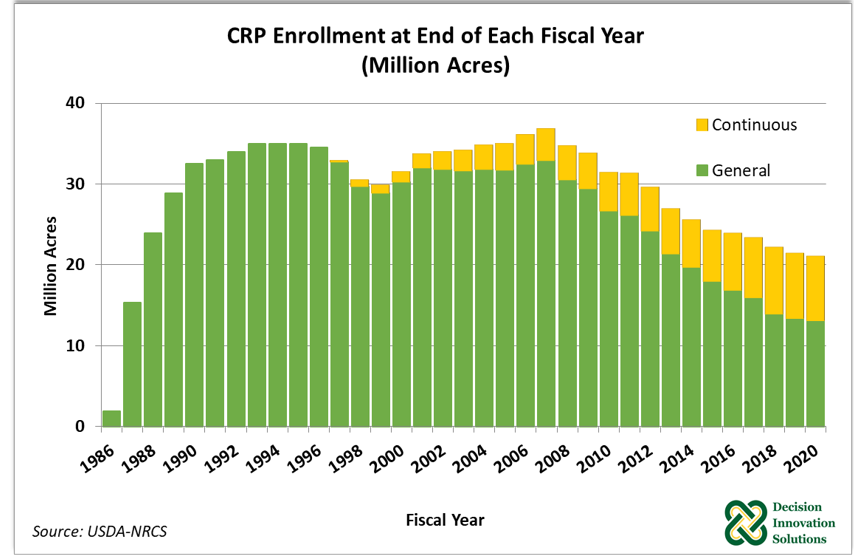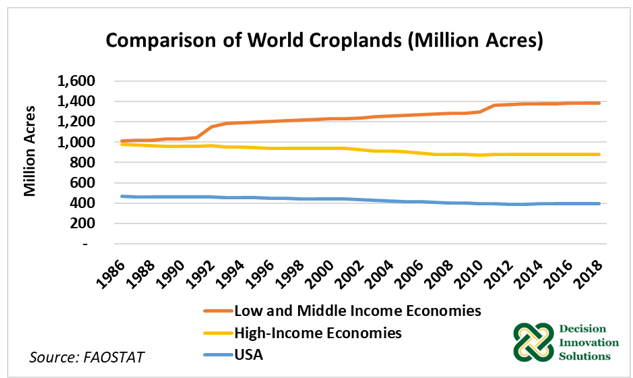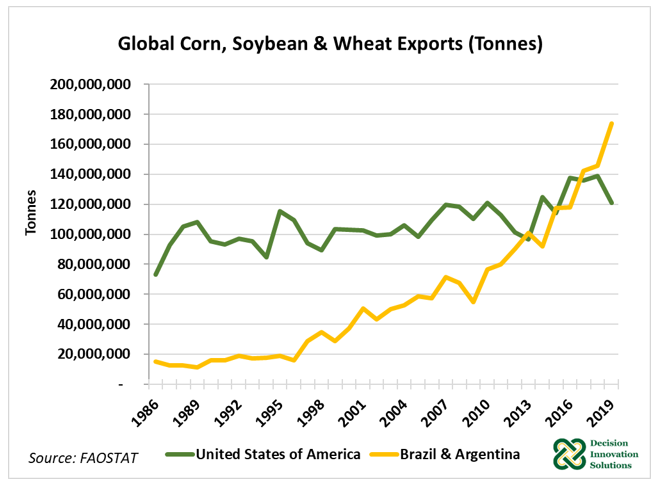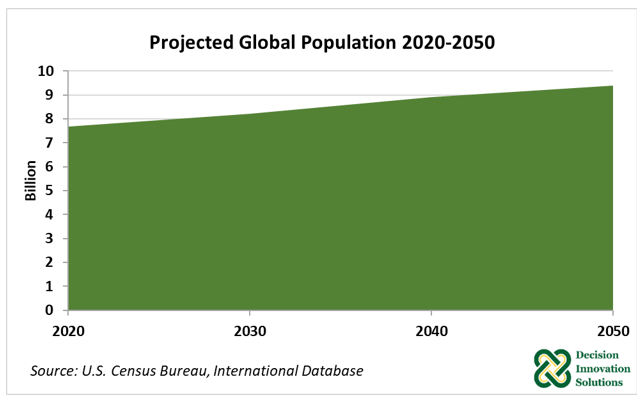Established under the 1985 Food Security Act, the Conservation Reserve Program (CRP) is primarily focused on: protecting otherwise arable land from erosion, improving water quality, and protecting wildlife habitats. The CRP works to achieve these through the voluntary retirement of environmentally sensitive cropland and highly erodible land from production through 10- or 15-year contracts. Cover crops of either trees or grasses and forbs are planted on the enrolled land, and participants in the program receive compensation for their land taken out of production.
In 1986 farmland began being enrolled in the CRP, and since then millions of acres have been enrolled through either the continuous or general enrollment process (see Figure 1). However, land idling due to the CRP has resulted in a reduction in agricultural production (Hellerstein, 2017). This article intends to discuss the trade-off between land conservation and reduction in the supply of agricultural commodities.
 Figure 1. General and Continuous Enrollment of CRP Land
Figure 1. General and Continuous Enrollment of CRP Land
Since the establishment of the CRP in the U.S. and comparable acreage-idling programs in a few other developed countries, croplands in developed countries have decreased. Conversely, low-income and middle-income economies, have been experiencing an increase in croplands since 1986. These global cropland trend lines for low-income, middle-income, and other high-income economies compared to the U.S. are shown in Figure 2.
 Figure 2. World Cropland by Income Strata
Figure 2. World Cropland by Income Strata
Crop-wise and country-wise, empirical investigation of these trends reveals that the international market has responded to the U.S. idled acres by planting and harvesting more acres of the crops for which the U.S. has foregone production.
The amount of foregone production in the U.S. has limited the growth of U.S. exports at a time when world demand has been increasing. With the intensity at which U.S. croplands have been idled under the CRP and the resultant increase in competing countries’ harvested acres, the volume of total corn, soybean, and wheat exports from the U.S. has not increased significantly since 1986. Meanwhile, Brazil and Argentina (the two largest competitors of the U.S.) have increased their exports of corn, soybeans, and wheat by nearly 900 percent (see Figure 3).
 Figure 3. Export Share of Corn, Soybeans, and Wheat
Figure 3. Export Share of Corn, Soybeans, and Wheat
As shown in Figure 4, the global population is projected to increase from 7.8 billion in 2020 to about 8.5 billion in 2050. With this projected increase in population, there is also an expected increase in the demand for crops to sustain the global population. In addition to this, per capita food consumption is also increasing globally, especially within developing countries (Mottaleb et. al. 2018).
 Figure 4. Projected Global Population 2020 – 2050
Figure 4. Projected Global Population 2020 – 2050
An increase in population and per capita food consumption has increased the overall demand for grains across the world. There is a high demand for exports of grains across the world. The U.S. has only been a marginal participant in meeting this increased demand of world markets due to the foregone production caused by CRP land idling. Hence this new demand is mostly met by competing countries such as: Argentina, Australia, Brazil, China, South Africa, and countries within the EU and FSU.
Arable land is a resource that should be protected; but the Conservation Reserve Program, although important, has resulted in a reduction in agricultural production (Hellerstein, 2017) and impacted the United States’ ability to contribute to the increasing global demand. Can the United States maintain a competitive standing in the global food production arena with millions of arable acres idling? Or, is there another way in which the trade-off between conservation and competition can be lessened while ensuring global food security?
References:

